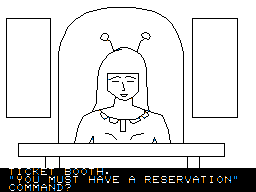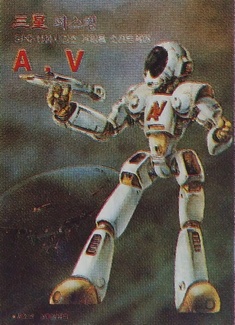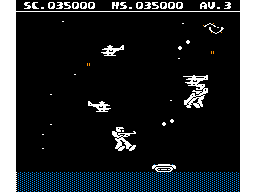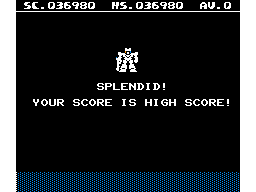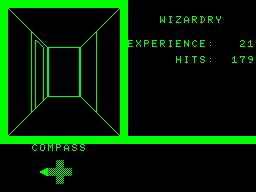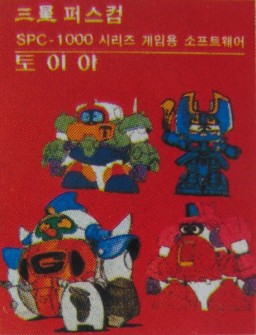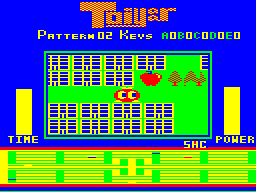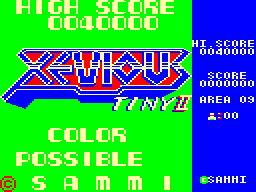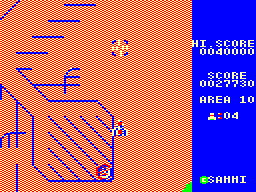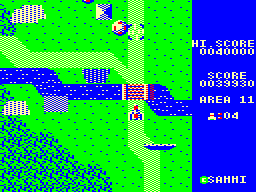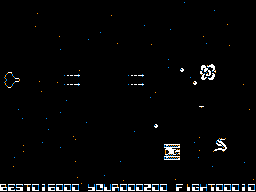A History of Korean Gaming
삼미 컴퓨터 Sammi Computer

|
Founded: |
unknown (around 1985) |
|
Status: |
defunct (around 1986) |
|
Key People: |
金鍾弼 김종필 Kim Jongpil: |
|
Website: |
none |
Not to be confused with the other Sammi Computer (now Sammi Information Systems), which is part of the Sammi group. This Sammi Computer was a small general hard- and software developer, like Static Soft contracted by Samsung to produce games for the SPC-1000. Starting out with edutainment titles in early 19851, the focus soon shifted towards conversions of Japanese computer games. The majority of their released titles were monochrome conversions of MSX games, and it seems at least some of them were officially licensed, as the copyright holders are properly credited in the ports of Dragon Slayer and The Goonies. Other known MSX to SPC-1000 monochrome ports not listed below are Konami's Billiards (retitled Danggu), King's Valley, Knight Lore, Rambo and Ninja Princess. Similar to Softmen, Sammi computer also had made lofty claims about exporting "products like Romance of the Three Kingdoms" (the statement is ambiguous about whether that meant software based on the classic chinese novel or games that are like the 1985 Koei game) to Japan,2 but it is doubtful whether this ambition amounted to anything.
After releasing the "Sammi Soft Box," a graphics enhancement unit for the SPC-1000 with an MSX cartridge slot,3 Sammi also acted as one of Korea's many MSX game copy factories, both for the Samsung computer and actual MSX machines. In the latter half of 1986, Sammi Computer releases were advertised together with Topia. Eventually Sammi's name disappeared from the ads, never to be seen again, which suggest it either went out of business or was absorbed by Topia.
Games
디즈니랜드 (Disney Land) - SPC-1000 (1985)
Tape Covers
Among Sammi's many monochrome conversions of MSX games, the port of Hudson's Dezeni Land stands out the most. Not only did Sammi further capitalize on the pun (or maybe simply failed to understand it) and bluntly named the game just Disney Land. The other peculiar detail is the language, as the game has been fully translated—not into Korean, but into English.
A detailed look at Dezeni Land and its sequel can be read in a separate article.
A.V: Armored Vehicle - SPC-1000 (1986)
Cover
This port of a PC-6001 game originally published with PIO 2/1986 is quite an interesting shoot-'em-up/run 'n gun. Steering a robot that can fire in eight directions and even fly into the air, one has to eliminate all the enemies that come at it. It's also possible to walk around the otherwise empty planet surface, but often it is more save to wait for the enemies and concentrate on avoiding their bullets while firing back at the same time.
When no enemies are left in the stage, a boss appears that can be shot for bonus points. The alternative is to just run away, since the stage ends as soon as the player is far enough away from it. There are only three different stages, but after them the game grants an extra life and starts from the beginning with more aggressive enemies.
A.V looks really nice for game in such a low resolution and color palette, but what comes out of the speakers during playing is just garbage.
Wizardry - SPC-1000 (1986)
Wizardry (SPC-1000)
Despite the title Sammi's Wizardry doesn't have much in common with the legendary RPG series other than taking place in an abstract first person representation of a dungeon. There's only two kinds of random encounters that both just diminish the player's HP while raising experience points, without any visual feedback or interaction from the player. The supposed goal is to find the exit at each stage. Graph paper and a pencil are mandatory tools.
토이야 (Toiyaar) - SPC-1000 (1986)
Cover
Originally a PC-6001 title from PiO '86/04, in Toiyaar the player takes control of what looks like a tomato with legs, and has to conquer huge labyrinths by finding keys and unlocking doors. Most of the labyrinth consists of houses and appartment blocks, which can be torned down with explosions. This is necessary because most items are hidden in the wreckage. Often the houses containing stuff are easily recognizable (like one single house in midst of skyscrapers), but others are just randomly hidden and require much experimenting.
Of course this is no walk in the park the tomato is sent to, as both time and dynamite are in limited supply, and guys with funny hats hunt it down all the time. The actual game window is very dense, so one has to rely on the map to avoid them, but the strange proportions don't make the job easy. After dying one has to restart the level all over again, and the long ways and slow walking speed soon start to bore.
Toiyar has some technical issues. The tomato blinks all the time, and the scrolling is rather strange, which puts a strain on the eyes quite fast. To its credit, the game suports music during gameplay, which wasn't a given at all with the SPC-1000, but the single tune is not exciting at all.
Xevious Tiny II - SPC-1000 (1986)
Xevious Tiny II (SPC-1000)
The port of the ever popular Xevious is based on Tiny Xevious mk II for the PC-6001, by Dempa. Because everything moves extremely choppy, it can be hard to spot the enemy bullets at all. After some getting used to it's not impossible, but it imposes a lot of stress on the eyes.
Otherwise the game is pretty faithful to the original, despite the humble title. It even retains the Andor Genesis boss, which is missing in some other low-end 8-bit home computer ports.
References
1. Maeil Gyeongje 4/23/1985, page 7
2. Computer Hakseup 5/1986, page not numbered
3. Computer Hakseup 9/1986, page 159

